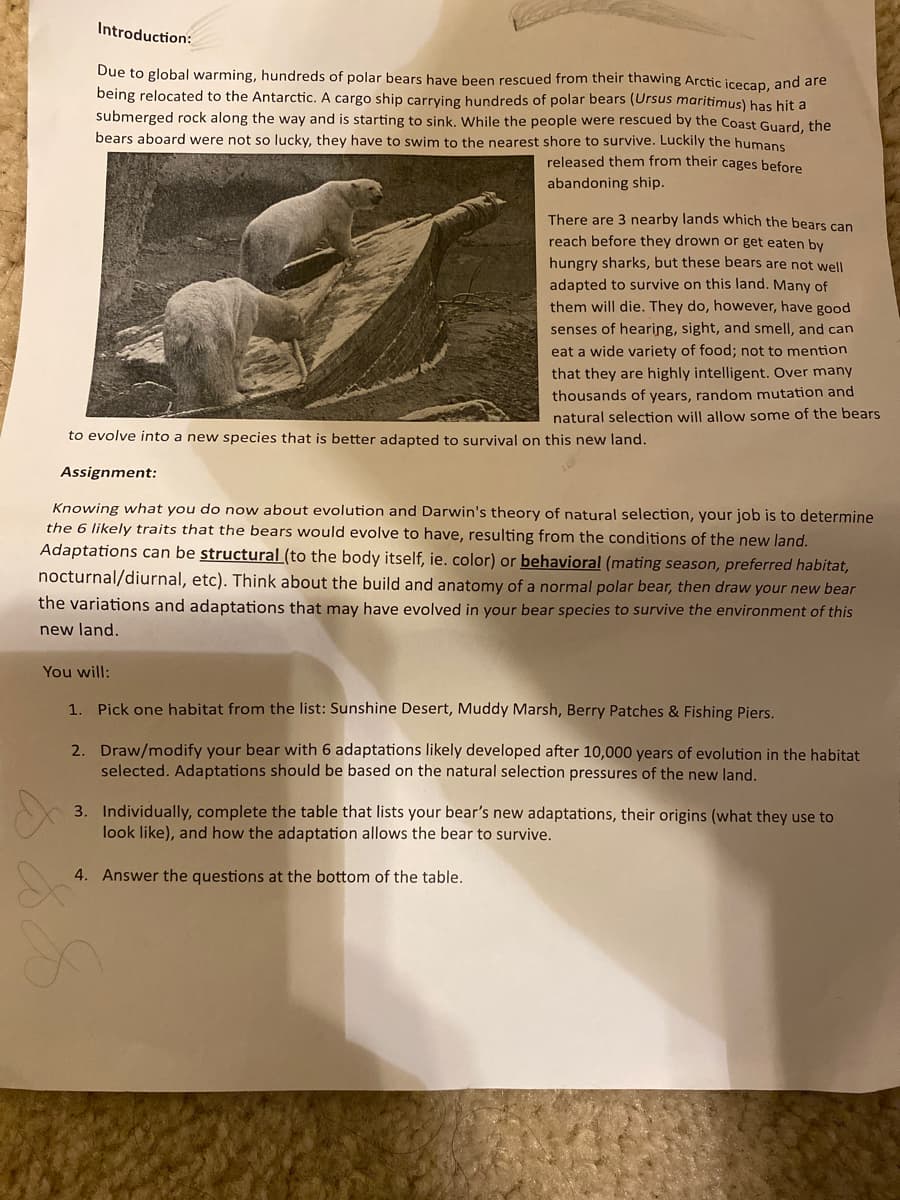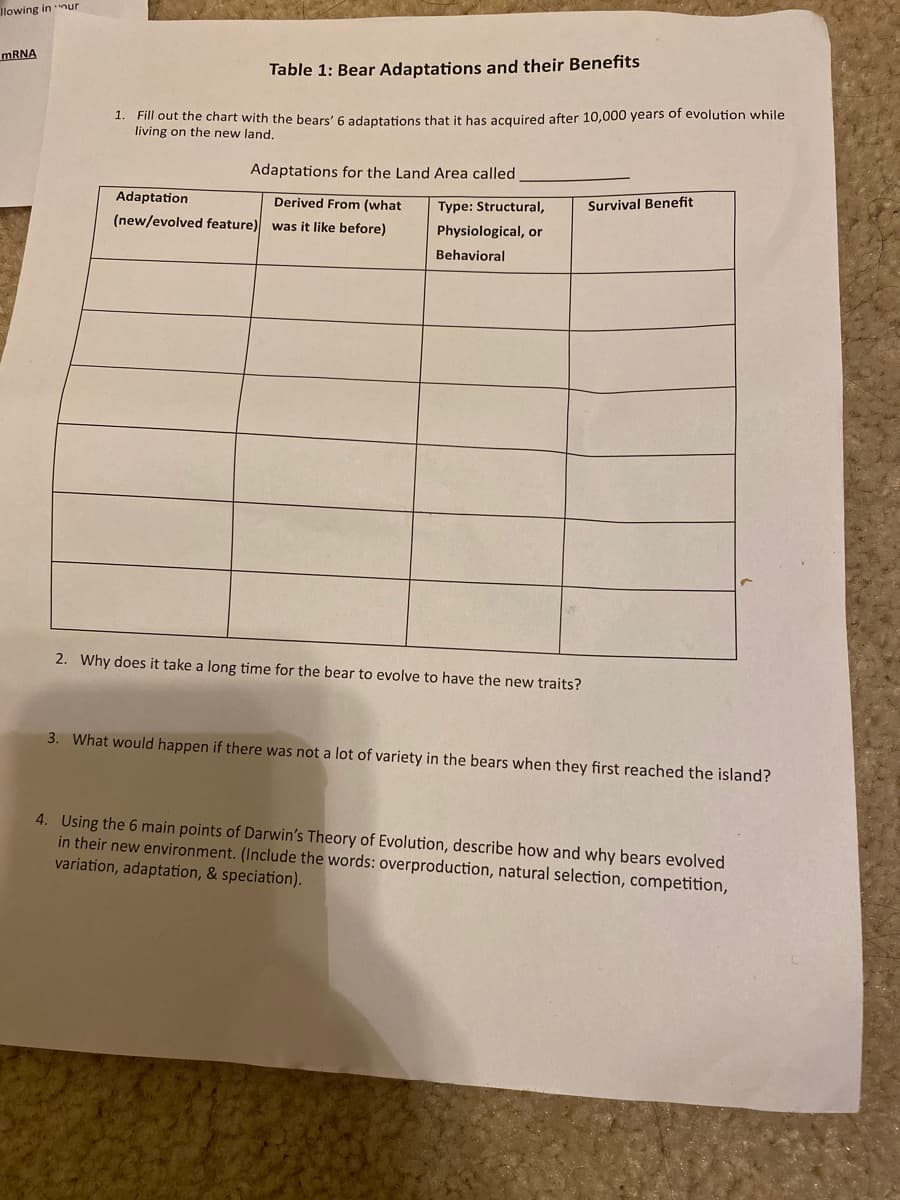Chapter37: Maintaining The Internal Environment
Section: Chapter Questions
Problem 3CT
Related questions
Question

Transcribed Image Text:Introduction:
Due to global warming, hundreds of polar bears have been rescued from their thawing Arctic icecap, and are
being relocated to the Antarctic. A cargo ship carrying hundreds of polar bears (Ursus maritimus) has hit a
submerged rock along the way and is starting to sink. While the people were rescued by the Coast Guard, the
bears aboard were not so lucky, they have to swim to the nearest shore to survive. Luckily the humans
released them from their cages before
abandoning ship.
There are 3 nearby lands which the bears can
reach before they drown or get eaten by
hungry sharks, but these bears are not well
adapted to survive on this land. Many of
them will die. They do, however, have good
senses of hearing, sight, and smell, and can
eat a wide variety of food; not to mention
that they are highly intelligent. Over many
thousands of years, random mutation and
natural selection will allow some of the bears
to evolve into a new species that is better adapted to survival on this new land.
Assignment:
Knowing what you do now about evolution and Darwin's theory of natural selection, your job is to determine
the 6 likely traits that the bears would evolve to have, resulting from the conditions of the new land.
Adaptations can be structural (to the body itself, ie. color) or behavioral (mating season, preferred habitat,
nocturnal/diurnal, etc). Think about the build and anatomy of a normal polar bear, then draw your new bear
the variations and adaptations that may have evolved in your bear species to survive the environment of this
new land.
You will:
1. Pick one habitat from the list: Sunshine Desert, Muddy Marsh, Berry Patches & Fishing Piers.
2. Draw/modify your bear with 6 adaptations likely developed after 10,000 years of evolution in the habitat
selected. Adaptations should be based on the natural selection pressures of the new land.
3. Individually, complete the table that lists your bear's new adaptations, their origins (what they use to
look like), and how the adaptation allows the bear to survive.
4. Answer the questions at the bottom of the table.

Transcribed Image Text:llowing in ur
MRNA
Table 1: Bear Adaptations and their Benefits
1. Fill out the chart with the bears' 6 adaptations that it has acquired after 10,000 years of evolution while
living on the new land.
Adaptations for the Land Area called
Adaptation
Derived From (what
Type: Structural,
Survival Benefit
(new/evolved feature) was it like before)
Physiological, or
Behavioral
2. Why does it take a long time for the bear to evolve to have the new traits?
3. What would happen if there was not a lot of variety in the bears when they first reached the island?
4. Using the 6 main points of Darwin's Theory of Evolution, describe how and why bears evolved
in their new environment. (Include the words: overproduction, natural selection, competition,
variation, adaptation, & speciation).
Expert Solution
This question has been solved!
Explore an expertly crafted, step-by-step solution for a thorough understanding of key concepts.
Step by step
Solved in 2 steps

Knowledge Booster
Learn more about
Need a deep-dive on the concept behind this application? Look no further. Learn more about this topic, biology and related others by exploring similar questions and additional content below.Recommended textbooks for you


Human Physiology: From Cells to Systems (MindTap …
Biology
ISBN:
9781285866932
Author:
Lauralee Sherwood
Publisher:
Cengage Learning

Biology 2e
Biology
ISBN:
9781947172517
Author:
Matthew Douglas, Jung Choi, Mary Ann Clark
Publisher:
OpenStax


Human Physiology: From Cells to Systems (MindTap …
Biology
ISBN:
9781285866932
Author:
Lauralee Sherwood
Publisher:
Cengage Learning

Biology 2e
Biology
ISBN:
9781947172517
Author:
Matthew Douglas, Jung Choi, Mary Ann Clark
Publisher:
OpenStax

Human Biology (MindTap Course List)
Biology
ISBN:
9781305112100
Author:
Cecie Starr, Beverly McMillan
Publisher:
Cengage Learning

Biology Today and Tomorrow without Physiology (Mi…
Biology
ISBN:
9781305117396
Author:
Cecie Starr, Christine Evers, Lisa Starr
Publisher:
Cengage Learning
